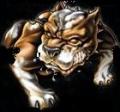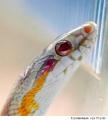Змии
#281

Публикувано: 02 December 2008 - 03:11 PM
Just like us, snakes constantly grow new skin cells and must shed the old skin cells. We shed our old skin cells continuously in small quantities, but snakes shed their old skins in a continuous sheet (a process called ecdysis). The interval between sheds depends on several factors, including age, growth rate, and environmental factors. Young, growing snakes shed frequently (every few weeks); adult snakes shed less often, perhaps a few times a year, sometimes less.
Signs Your Snake is About to Shed
Eyes turn a cloudy, bluish color (the eye cap, a specially adapted scale which covers the eye, is loosened up in order to be shed along with the skin, which causes this change). Just prior to shedding, the eyes will clear up again.
Skin becomes dull or hazy in appearance (sometimes the belly may appear a little pink at first)
Your snake may hide more than usual and go off food.
Your snake may become more skittish or defensive because it can't see well.
When your snake is ready to shed, he or she will seek out rough surfaces in the enclosure to help rub the skin off.
Care for Your Shedding Snake
Provide some cage accessories to help your snake rub off the old skin such as clean driftwood and rocks (which should still be pretty smooth, not rough).
Make sure your snake has enough humidity - a shallow dish of water in which it can soak, and / or a humidity hide box (an enclosed plastic container, with an entry hole just big enough for the snake to fit in, containing damp sphagnum moss).
Avoid handling your snake as much as possible (gentle handling is okay if necessary, but the process is stressful and the new skin is delicate, so avoid unnecessary handling)
If your snake goes off food, don't worry (a healthy snake can go a couple of weeks without eating). However, if your snake wants to eat, it may be best to feed a smaller meal than usual to minimize the effort your snake need to digest a meal during the shedding process.
When your snake has shed, examine the shed skin to make sure the shed was complete. Ideally, the whole skin will come off in one piece, and the eye caps should be shed along with the skin (there should not be holes where the eyes were). If your snake has not shed the whole skin or the eye caps, see ore about shedding problems below.
Shedding Problems [br[If your snake does not completely shed its skin (an incomplete shed, also called dysecdysis), it can signal health problems or problems with husbandry (e.g. humidity levels). Retained eye caps (where the eye caps are not shed along with the skin) may occur with an incomplete shed, but may also occur even if the rest of the skin was shed intact. For help with either of these problems, see the following links:
*Shedding Problems in Reptiles
*Retained Eye Caps in Snakes
For more information on shedding including photos of a snake getting ready to shed and what the shed skin should look like, see All About Shedding (external link).
Signs Your Snake is About to Shed
Eyes turn a cloudy, bluish color (the eye cap, a specially adapted scale which covers the eye, is loosened up in order to be shed along with the skin, which causes this change). Just prior to shedding, the eyes will clear up again.
Skin becomes dull or hazy in appearance (sometimes the belly may appear a little pink at first)
Your snake may hide more than usual and go off food.
Your snake may become more skittish or defensive because it can't see well.
When your snake is ready to shed, he or she will seek out rough surfaces in the enclosure to help rub the skin off.
Care for Your Shedding Snake
Provide some cage accessories to help your snake rub off the old skin such as clean driftwood and rocks (which should still be pretty smooth, not rough).
Make sure your snake has enough humidity - a shallow dish of water in which it can soak, and / or a humidity hide box (an enclosed plastic container, with an entry hole just big enough for the snake to fit in, containing damp sphagnum moss).
Avoid handling your snake as much as possible (gentle handling is okay if necessary, but the process is stressful and the new skin is delicate, so avoid unnecessary handling)
If your snake goes off food, don't worry (a healthy snake can go a couple of weeks without eating). However, if your snake wants to eat, it may be best to feed a smaller meal than usual to minimize the effort your snake need to digest a meal during the shedding process.
When your snake has shed, examine the shed skin to make sure the shed was complete. Ideally, the whole skin will come off in one piece, and the eye caps should be shed along with the skin (there should not be holes where the eyes were). If your snake has not shed the whole skin or the eye caps, see ore about shedding problems below.
Shedding Problems [br[If your snake does not completely shed its skin (an incomplete shed, also called dysecdysis), it can signal health problems or problems with husbandry (e.g. humidity levels). Retained eye caps (where the eye caps are not shed along with the skin) may occur with an incomplete shed, but may also occur even if the rest of the skin was shed intact. For help with either of these problems, see the following links:
*Shedding Problems in Reptiles
*Retained Eye Caps in Snakes
For more information on shedding including photos of a snake getting ready to shed and what the shed skin should look like, see All About Shedding (external link).
#284

Публикувано: 08 December 2008 - 06:21 PM
Цитат
LUN, тези размери са малко стряскащи за мен :o .Ти как мислиш?Тъкмо като гледах клипчето си мислех..."главата му ще е в моята стая,а опашката в хола ;D.
Да ви се похвалия,вече хапнахме- за пръв път от както е при мен ;)
Да ви се похвалия,вече хапнахме- за пръв път от както е при мен ;)
Стряскам се и още как :blink: Най-много ме притеснява това,че като стане толкоз голям ще ми е трудно да го обслужвам.Ще трябва да си взимам помощник, едва ли ще мога да го помръдна сам ;D Също така и за изхранването се замислям, но има време ще видиме какво ще се прави B) За сега му се кефя на макс!
#287

Публикувано: 10 December 2008 - 03:39 PM
Pomorieca змията изразходва много от енергията си при смяна на кожата и за това е освирепяла от глад, ако е на кеф тъпче веднага, а при паяците не се изчаква, защото не е гладна тарантулата, а защото хитиновата обвивка не се е втвърдила и е опасно за самият паяк ;) .

Моята змия НЕ яде кучета и котки!
#289

Публикувано: 22 December 2008 - 01:55 PM
А вие какви видове змии бихти припоръчали(не отровни)попринцип като за домашни любимци? :blink:
#290

Публикувано: 22 December 2008 - 03:21 PM
Царевичен смок, кралски питон, боа, млечна змия, кралска змия, тигров питон, амурски смок, свиненоса змия, дъгова боа, зелен дървесен питон, кървав питон, кучеглава боа, жълта парагвайска анаконда, мрежест питон, иероглифски питон, зелена дървесна боа.

Моята змия НЕ яде кучета и котки!
#291

Публикувано: 22 December 2008 - 05:48 PM
;D ;D Мерси братче железен си! :palec: :palec:
#298

Публикувано: 04 January 2009 - 05:37 AM
За много години на всички.Здраве,късмет,пари,любов и много змиичета ;D
Искам да ви питам нещо-моята пакосница неспира да се катери горе на терариума и постоянно пада от високо,а и на лампата се гори.Проблем ли е това?Оф и тия петна не и изчезнаха,а станаха по-ярко изразени това също може ли да се получи от постоянните и допири на проклетата лампа?
Искам да ви питам нещо-моята пакосница неспира да се катери горе на терариума и постоянно пада от високо,а и на лампата се гори.Проблем ли е това?Оф и тия петна не и изчезнаха,а станаха по-ярко изразени това също може ли да се получи от постоянните и допири на проклетата лампа?


 Вход
Вход Регистрация
Регистрация Помощ
Помощ




 Горе
Горе Цитиране +
Цитиране +

